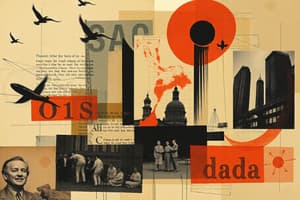Podcast
Questions and Answers
According to the Representational Change Theory, which cognitive process involves altering what is considered permissible to arrive at a solution?
According to the Representational Change Theory, which cognitive process involves altering what is considered permissible to arrive at a solution?
- Re-encoding, which involves reinterpreting elements of the problem.
- Algorithmic Decomposition, where the problem is broken into smaller parts.
- Elaboration, which focuses on enriching the problem with additional details.
- Constraint Relaxation, where the boundaries of the problem are adjusted. (correct)
In the context of matchstick arithmetic problems, what does Knoblich et al.'s research suggest about solvers who successfully overcame initial fixations?
In the context of matchstick arithmetic problems, what does Knoblich et al.'s research suggest about solvers who successfully overcame initial fixations?
- They relied solely on prior knowledge without exploring alternative strategies.
- They rapidly tried different combinations without much deliberation.
- They increased their attention to the operators, demonstrating constraint relaxation. (correct)
- They focused primarily on altering the numerical values in the equation.
Which of the following statements best summarizes the relationship between functional fixedness and creativity in problem-solving?
Which of the following statements best summarizes the relationship between functional fixedness and creativity in problem-solving?
- Functional fixedness limits creativity by restricting thoughts to conventional applications. (correct)
- Functional fixedness enhances creativity by encouraging focus on familiar object functions.
- Functional fixedness has no impact on creativity when solving novel problems.
- Functional fixedness and creativity are positively correlated cognitive processes.
According to introspective accounts of creativity, what role does intrinsic motivation play in fostering creative thinking?
According to introspective accounts of creativity, what role does intrinsic motivation play in fostering creative thinking?
How does the 'incubation' stage, as described by Graham Wallas in his stages of thinking, potentially contribute to creative problem-solving?
How does the 'incubation' stage, as described by Graham Wallas in his stages of thinking, potentially contribute to creative problem-solving?
In the context of the Remote Associates Test (RAT), what key finding did Smith & Blankenship's 1991 study reveal regarding incubation periods?
In the context of the Remote Associates Test (RAT), what key finding did Smith & Blankenship's 1991 study reveal regarding incubation periods?
Which cognitive explanation suggests that incubation works by allowing the 'forgetting' of counterproductive mental sets or unnecessary constraints?
Which cognitive explanation suggests that incubation works by allowing the 'forgetting' of counterproductive mental sets or unnecessary constraints?
How do divergent and convergent thinking, as defined by Guilford, interact to promote optimal problem-solving?
How do divergent and convergent thinking, as defined by Guilford, interact to promote optimal problem-solving?
In Finke's Geneplore model, what is the primary difference between the 'generation' and 'exploration' phases of creative thought?
In Finke's Geneplore model, what is the primary difference between the 'generation' and 'exploration' phases of creative thought?
Which of the following best characterizes how morphological creativity enhances idea generation, according to the information provided?
Which of the following best characterizes how morphological creativity enhances idea generation, according to the information provided?
Flashcards
Representational Change Theory
Representational Change Theory
A cognitive theory of problem-solving, explaining how people overcome impasses and achieve insights in challenging problems.
Elaboration (in problem solving)
Elaboration (in problem solving)
Adding more information to the problem representation.
Constraint Relaxation
Constraint Relaxation
Changing what constraints are permissible in solving the problem.
Re-encoding
Re-encoding
Signup and view all the flashcards
Gestalt Approach to Insight
Gestalt Approach to Insight
Signup and view all the flashcards
Brainstorming
Brainstorming
Signup and view all the flashcards
Deferment of Judgement
Deferment of Judgement
Signup and view all the flashcards
Morphological Creativity
Morphological Creativity
Signup and view all the flashcards
Incubation period
Incubation period
Signup and view all the flashcards
Creativity
Creativity
Signup and view all the flashcards
Study Notes
- Cognitive psychology explores creativity, particularly individual differences and cognitive processes contributing to creative thought.
- Emphasis is placed on understanding how creative thought occurs.
- Original or novel ideas do not necessarily have to be useful or worthwhile to be considered creative.
Creativity in the Arts
- Creativity can set a new style or movement.
- Evaluating the 'worth' of artistic creations is difficult.
Creativity in Science
- Creativity includes new paradigms, useful inventions, and theories that explain more phenomena with fewer assumptions.
Introspective Account of Creativity
- The introspective account emphasizes how self-reflection and internal exploration foster creative thinking.
- Self-reflection and awareness involve looking inward to understand one's mental processes, motivations, and emotions.
- Intrinsic motivation fuels creativity, driven by personal satisfaction, curiosity, or passion, rather than external incentives.
Graham Wallas' 4 Stages of Thinking
- Wallas described four stages of thinking based on introspection and reports from "great thinkers".
- Preparation involves systematic, conscious, and initially fruitless work on a problem.
- Incubation occurs when the problem is set aside for other work.
- Illumination is when the solution to the problem presents itself as a sudden insight.
- Verification is when the solution is developed and tested.
Remote Associates Test (RAT)
- The Remote Associates Test (RAT) involves seeing three unrelated words and finding a fourth that ties them together.
- Studies using RAT have shown that participants who took an incubation break were more likely to solve previously unsolved problems when retested.
- Taking a break (incubation) from a problem leads to improved problem-solving performance.
Why Incubation Works
- Incubation allows for the 'forgetting' of unnecessary constraints or the decay of mental sets.
- During incubation, representations related to the problem remain active and interact with long-term memory.
- He theory suggests that problem-related concepts in memory continue to be activated during incubation.
Introspection Theory Evaluation
- While introspection provides a useful framework for describing creativity and has empirical support for incubation, it is primarily descriptive rather than explanatory.
- The question is raised whether illumination is always a necessary stage and if insight always occurs.
Guilford's Two Types of Creativity
- Guilford identified two types of creative processes: divergent thinking and convergent thinking.
- Divergent thinking involves fluency and novelty, searching for new solutions.
- Convergent thinking involves searching for an 'optimal' solution.
- Both Divergent and Convergent thinking should be used together for optimal problem solving.
Creative Cognition: Geneplore Model
- The Geneplore model, proposed by Fink, suggests that creative thought occurs in two stages, generation and exploration.
- During the generation phase, develop ‘preinventive forms’ or ideas that while are not necessarily solving the problem, can be potentially useful.
- Preinventive forms derive from prior knowledge and involve divergent thinking.
- Next is the exploration phase which utilizes preinventive forms to address the problem through convergent thinking.
- If no solution is found, the cycle returns to the generation stage.
Fink's 1996 Study
- Participants given three object parts to combine into an interesting form, then interpret and describe as a practical object or device.
- Generating preinventive structures before knowing the design goal led to more creative inventions overall.
Path-of-Least-Resistance
- New ideas are often constrained by existing knowledge, relying heavily on it to create new forms.
- Ward's study on imaginary creatures showed that created animals resembled earth animals suggesting a strong influence of prior knowledge and cognitive efficiency.
Geneplore Model Evaluation
- There is some empirical evidence that generation and exploration are crucial processes
- Deferring the evaluation of forms increases novelty.
- However, this model does not describe the processes involved in generating preinventive forms, focusing instead on originality rather than creativity per se.
Improving Creativity via Brainstorming
- Alex Osborn suggested that brainstorming increases idea production.
- The two main principles of brainstorming are a deferment of judgement and quantity breeds quality.
- The four rules are: no evaluation or criticism, encourage wild ideas, quantity over quality, and build on the ideas of others.
Brainstorming Efficiency
- Brainstorming produces more good ideas vs. no brainstorm group.
- Brainstorming is an effective strategy to generate new and useful ideas.
Morphological Creativity
- Zwicky's box involves identifying and defining the parameters or dimensions of a problem.
- Next, a range of variations or possibilities for each parameter are generated.
- These variations are combined in all possible ways to create a multidimensional matrix.
- The resulting combinations are analyzed and evaluated for feasibility and novelty.
Allen's Approach to Morphological Creativity
- Morphological creativity is a problem-solving and idea-generation technique.
- Ideas are found by combining 2 points in the matrix and ideas are then evaluated.
Efficiency of Morphological Creativity
- Morphological synthesis is an effective method to produce good ideas.
Functional Fixedness
- Functional fixedness limits creativity by confining thinking to conventional uses of objects or ideas.
Summary of Key Points
- Creative thought can effectively be studied as a form of ill-defined problem solving
- Wallas provided a reasonable description of creative thought
- Guilford coined 'convergent' and 'divergent' thinking
- Ward and colleagues suggest processes in creative thought, supported by empirical evidence
- Methods such as brainstorming and morphological synthesis can facilitate creative thought
Studying That Suits You
Use AI to generate personalized quizzes and flashcards to suit your learning preferences.



